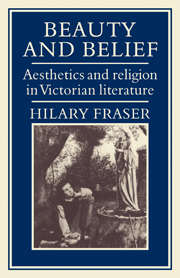Book contents
- Frontmatter
- Contents
- Dedication
- Acknowledgements
- List of abbreviations
- Introduction
- 1 Theology: Keble, Newman, and the Oxford Movement
- 2 Epistemology and perception: Gerard Manley Hopkins
- 3 Criticism: John Ruskin and Matthew Arnold
- 4 Aestheticism: Walter Pater and Oscar Wilde
- Conclusion
- Notes
- Select bibliography
- Index
2 - Epistemology and perception: Gerard Manley Hopkins
Published online by Cambridge University Press: 05 November 2011
- Frontmatter
- Contents
- Dedication
- Acknowledgements
- List of abbreviations
- Introduction
- 1 Theology: Keble, Newman, and the Oxford Movement
- 2 Epistemology and perception: Gerard Manley Hopkins
- 3 Criticism: John Ruskin and Matthew Arnold
- 4 Aestheticism: Walter Pater and Oscar Wilde
- Conclusion
- Notes
- Select bibliography
- Index
Summary
It is customary to consider Hopkins' theory of inscape as sui generis, the philosophy of a solitary mystical and poetical visionary. Its fusion of Parmenidean, Platonic, and Scotist concepts with a distinctive and innovative aesthetic is indeed unique, reflecting the virtual isolation of Hopkins, as a Jesuit priest, from the mainstream of Victorian letters. Yet, in that it represents an attempt to relate ideas about beauty, art, and religion into one comprehensive philosophy, the idea of inscape places Hopkins very centrally in the post-Romantic religio-aesthetic tradition which defines Victorian aesthetic thought. Keble and Newman were both poets and critics of poetry, yet the main focus of their intellectual effort and achievement was religious. Hopkins dedicated his life to a religious vocation, but his distinction for the modern reader is as a poet and literary theorist. All three men pursued a philosophical synthesis which would incorporate their religious commitment and their passion for art. If Keble and Newman as a result ‘made the Church of England poetical’, then Hopkins just as convincingly made the figure of Christ fundamental to his theories about perception, beauty, and poetry.
There is in the large body of literature on Hopkins a dogged critical emphasis on the conflict between his exaggerated conscience and priestly vocation on the one hand and his poetical genius and intense vulnerability to beauty on the other. Certainly an acute tension existed between the ‘priest’ and the ‘poet’ in him, a tension which undeniably broke down at crucial points in his life.
- Type
- Chapter
- Information
- Beauty and BeliefAesthetics and Religion in Victorian Literature, pp. 67 - 106Publisher: Cambridge University PressPrint publication year: 1986



